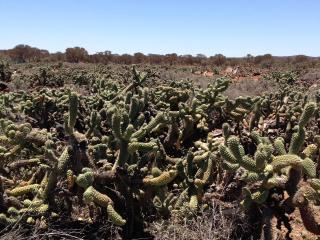As part of Cactus Month during November, landholders and community groups have been reminded to look out for and report cactus.
Department of Agriculture and Food priority weed response manager Kay Bailey said cacti impacted on agriculture, posed a threat to livestock and competed with native vegetation.
“The aim of Cactus Month is to increase awareness of the impact of cacti and its potential to spread, and improve control of the pest plant,” Ms Bailey said.
“Cacti segments can be spread by floodwater and animals including cattle and kangaroos, and the cacti grow where they lodge.
“The best way to prevent the spread of cactus is to control pest plant populations while they are small.
“A range of control methods is available, including mechanical and manual removal, chemical spraying and injection, fire and biological approaches.
“For larger infestations, an integrated approach may be required.”
Western Australia has a relatively low number of known infestations and a small total area of infested land compared to other Australian states.
In north-central Victoria, dense wheel cactus infestations cover 10,000 hectares of land, while it has been estimated that in South Australia, cacti impact about 930,000 hectares.
Ms Bailey said in WA, several coral cactus (Cylindropuntia fulgida var. mamillata) plants discarded at a tip on Tarmoola Station in the Shire of Leonora a decade ago, quickly spread to become what is now the largest known infestation of coral cactus in the State.
The core infestation was approximately three hectares, with isolated clumps spread over an additional area of 66km2.
“Local pastoralists and biosecurity group members have rallied to control the coral cactus infestation,” Ms Bailey said.
“Since 2013, the Goldfields Nullarbor Recognised Biosecurity Association (GNRBA) has coordinated the planning and control of this and other local cactus infestations, significantly reducing the extent and spread of the cactus.
“This kind of coordinated community approach is particularly successful in pastoral and agricultural areas where cacti are dispersed over a widespread area.
“Prevention is the best method of reducing the impact of cactus.
“Report and control cactus as soon as you become aware of it.”
Cacti finds can be reported to the department by calling the Pest and Disease Information Service on freecall 1800 084 881 or by using the free smartdevice app MyWeedWatcher, which is available free from the iTunes App Store and Google Play.

Media contacts: Jodie Thomson, Dionne Tindale, media liaison +61 (0)8 9368 3937
